GOOD BERRIES, BAD(?) BERRIES
Sad, Then Happy
A sad day here on the farmden: the end of blueberry season. Frozen blueberries, that is. Seventy quarts went into the freezer last summer, and a lot more than that into bellies, and now they’re all finished.
A happy day here on the farmden: the first of this season’s blueberries are ripening. These blueberries, and those that were in the freezer, are the large “highbush” (Vaccinium corymbosum) varieties commonly found fresh on market shelves. Also ripening now are “lowbush” (V. angustifolium) blueberries, growing as a decorative, edible ground cover on the east-facing slope near my home.
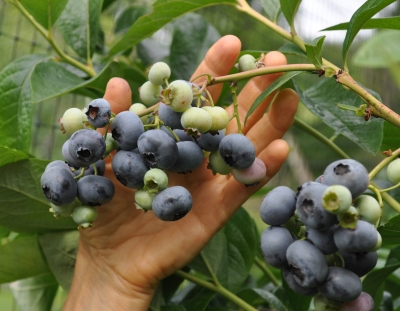
I’ve said it before but I’ll say it again. After many, many years of growing fruits in my not-particularly-good-for-fruit-growing site, blueberries — a native fruit — have always yielded well. Two most important things are adapting the soil to blueberries’ unique requirements, and keeping birds at bay. Birds at bay? Best is a walk-in, netted area.
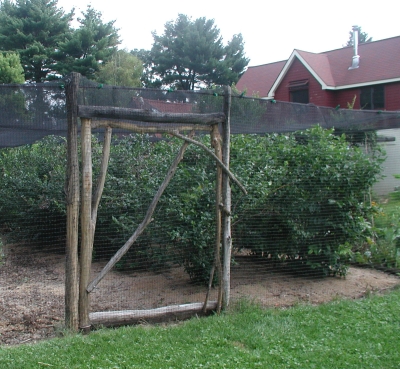
Soil for blueberries needs to be very acidic, with a pH between 4 and 5.5, made so, if needed, with the addition of sulfur, a naturally mined mineral. The pelletized form is best because it’s not dusty. Blueberry roots need good drainage and consistent moisture. They thrive in ground rich in organic matter, maintained with an annual three-inch topping of some weed-free, organic material such as wood shavings, wood chips, straw, pine needles, and autumn leaves.
(That’s the bare bones for success with blueberries. For a deeper dive into growing this healthful, delicious, reliable fruit, stay tuned for my soon-to-be-aired blueberry webinar.)
And More Berry-Like Fruits Coming Along
Just as last year’s apples were losing their crispness and tang and I needed a change from oranges, other berries, in addition to blueberries have started changing color, softening, and turning flavorful.
Black currants are another one of my favorites now ripening. They admittedly have an intense flavor not to everyone’s liking. But everyone likes black currants conjured up into juices, pastries, or jam. Variety matters. My favorites are Belaruskaja, Minaj Smyrev, and Titania.
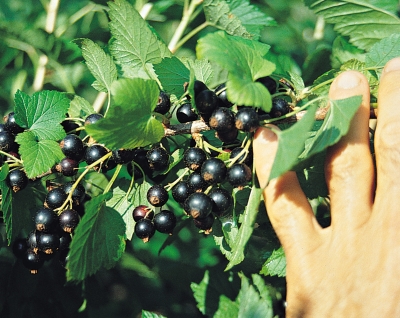
Don’t think black currants taste anything like “dried” or “Zante” currants. Those are raisins, originally made from “Black Corinth” grapes, a name then bastardized to “black currant.”
Like blueberries, black currants are easy to grow. But they have no special soil requirements, they fruit well even in some shade, and deer rarely eat the bushes, and birds rarely eat the berries.
Another tasty morsel now ripe is gumi (Elaeagnus multiflora). Birds usually strip this shrub clean of fruit, except this year the crop is so abundant that neither I nor the birds can make much of a dent in it. The berries are a little astringent if not dead ripe. And not at all if the fruit is processed; last year I cooked them slightly, strained out the seeds (which are edible), and blended it before drying it into a “leather.”

The gumi shrub itself has silver leaves, providing an attractive backdrop for the red fruits. The flowers are extremely fragrant, and the roots enrich the soil by taking nitrogen from the air (with the help of an actinomycete microorganism.)
Also now abundant, with plenty for all, is Nanking cherry (Prunus tomentosa), a favorite of mine for beauty and easy-to-grow cherries. The cherries are small, usually no larger than about 3/8 inch. But the single pit is also small. Flavor lies somewhere on the spectrum between sweet and sour cherries, very refreshing especially when chilled.

Nanking cherry fruit and bloom
Another Chance, and Then Another
All is not rosy in the berry-size fruit world. Over the years, I had heard about and tried a new fruit in town, edible honeysuckles. In the past, the plants I tried either died over winter or bore very few, very mediocre berries. Since then, edible honeysuckles have come up in the world, with serious breeding work, and I was given the opportunity to try them again. (As Maria Schinz said, “Gardening is an exercise in optimism.”)
But first, what is an edible honeysuckle, which now goes under better names. If called “honeyberry,” it usually refers to Russian species such as Lonicera caerulea app. kamtshatica or edulis. Haskap is a Japanese name applied the Japanese species L. caerulea spp. emphylocalyx, or to hybrids of this species with Russian species. Pure Japanese species varieties are sometimes called Yezberry, after the Island of Hokkaido, called Yez or Yezo Island where they are found. The Japanese species and hybrids are less susceptible to spring frosts than the honeyberries.
This spring I planted out two Yezberry varieties, Solo and Sugar Mountain Blue. The small, blue berries ripen early, and I was eager to give this fruit another try. Solo is bearing. The taste? Awful! Sour, with no other flavor.
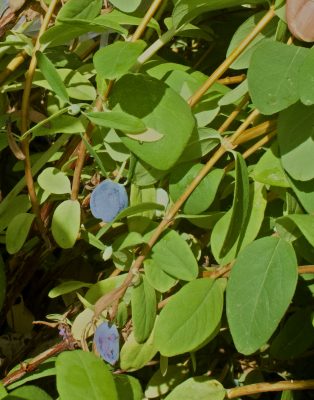
Solo yezberry
But I’m not abandoning edible honeysuckles. I’ve learned that the berries need to hang on the branches for a long time before developing full flavor and sweetness. A number of varieties are available, some of which are, according to others, “Delicious when eaten fresh from the plant” and “a bit like a cross between a raspberry and a blueberry. . . sweetness of a raspberry with a hint of pleasant tartness.” Really?!
Many blue berries are still hanging on my Solo bush. I’ll leave them to hang longer there and perhaps morph from “awful” to “delicious,” and will report back. I have hope for this new fruit, not yet high hopes.
At the very least, honeyberries or haskaps might be able to tide me over from the end of frozen blueberries to the first of fresh blueberries.

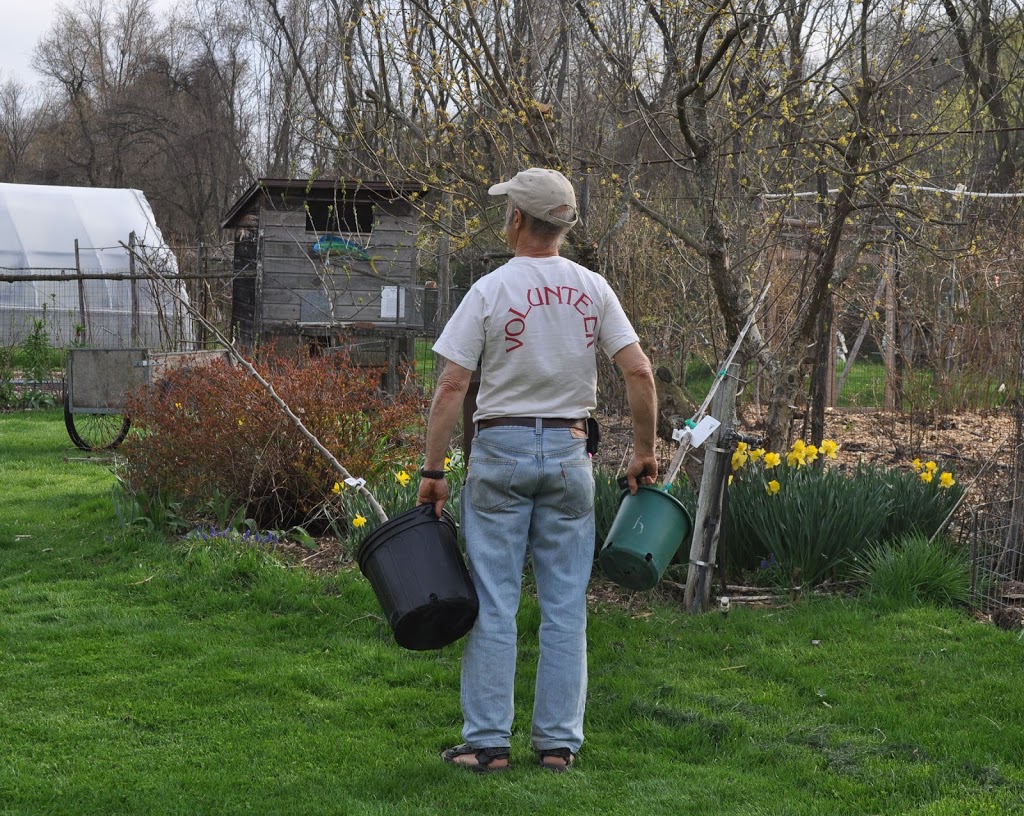
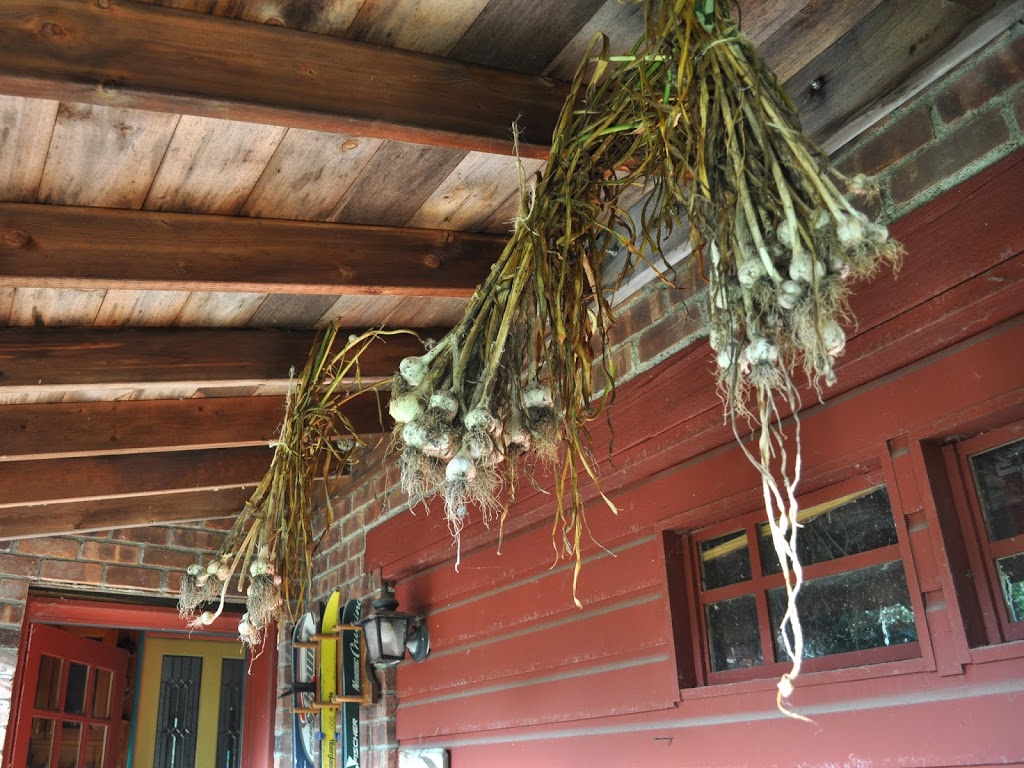
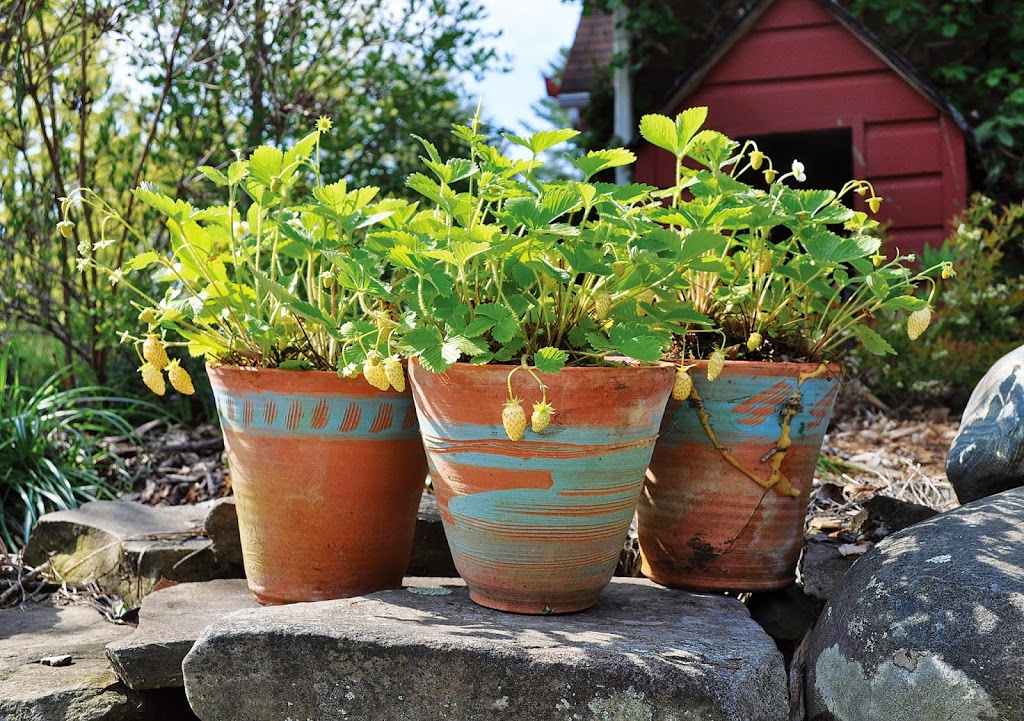

I have had a tough time the last 2 years keeping birds out of my plastic netting cage. I believe they are actually able to cut through the netting. My next years cage will be metal cloth 1/2 ” holes.
wow. That’s some intense bird control.
I’ve grown honeyberries for about 10 years now and I’ve found either I’m better at figuring out when they are ripe or they improve in flavor as the bush ages. Either way, I had the same reaction the first few years but now they are a family favorite. Mine do get sweet. I don’t pull the fruit. I just tickle the berry clusters and if any fall they seem to be sweet and ripe. All of mine are late blooming culitvars. Not so much for the frost here in the PNW but for our low pollinator action in cool moist spring.
Okay, I’ll keep mine and re-evaluate (over the years?).
Your season is earier than my Blueberries.
I am just starting to pick the main harvest.
Do you have a brand/supplier of bird netting you would recommend? I need to replace mine.
Have you experienced Che (Maclura tricuspidata zones, 5b and up)? I just read that Michael Judd (author, grower) called them the best fruit he’d eaten, but only a seedless variety. Trees of Joy sells them, but is currently out.
I like the netting sold by Raintree Nursery (one of my blog advertisers).
I’ve grown che. It’s not really cold hardy here. I describe the fruit itself in a chapter on che in my book UNCOMMON FRUITS FOR EVERY GARDEN (out of print but soon to be available for reading online), “Were you to meld together all the characteristics of a fresh fig and a mulberry—both, incidentally, relatives of che—you would end up with something very close to a che fruit. To wit, che is an inch to an inch and a half across, round, and dull maroon with a rich red interior, a slightly chewy texture, and a few edible seeds. The flavor is most definitely fresh fig plus mulberry, although neither as rich as the fig nor as sweet as the mulberry.”
I had the same experience with honeyberry when I grew two different varieties here in Maryland! I planted some Nanking cherries after reading your endorsement of them, and I have to say that they’re wonderful. I was wondering whether you’ve tasted any of the fruit of the P. japonica x P. jacquemontii hybrid I’ve seen for sale in a few places. Supposedly they ripen in late summer, but I have yet to see them in person.
I read about Jan and Joy years ago but for some reason never tried them. I’m tempted, except that they’d probably get the insect and disease problems that cherries are famous for, except Nankings.
Hi Lee:
Just touching base on your Farm Den.
I made myself one not as large with 10 thansplants last fall into spring. At the moment all are growing and even some with berries.
I am looking forward into seeing just what I can produce in a more controlled area.
I have a field of ca 200 but the weeds took control so I went mad a cut them down but transplanted a few into my den.
Have you grown Aronia?
What about Elderberries?
I have these two berry plants on another den along with Blackberries (thornless).
I like following up on your success.
Thanks,
Ken F.
I don’t grow aronia. It tastes awful. I’m not that hungry. Elderberry doesn’t taste so great either, but it has documented health benefits, so I grow it and make a syrup from it. The bush also is very beautiful.
What are your favorite blueberry varieties?
I never met a highbush blueberry I didn’t like. With that said, Jersey is slightly one of my favorites.
Do you set up and take down your walk in house every year (because of snow)?
Yes, but I only take down the “roof”. It takes about 1/2 hour to put it up or take it down.
Hi Lee,
Thanks for your consistently good information!
Like you, I love blueberries and black currants. I have five varieties of blueberries but ‘Patriot’ seems to perform the best every year.
The ‘Hills Kiev’ black currants are the stars in productivity and taste here.
They are so productive, some branches rest on the ground because of berry weight. Do your black currants droop, ….do you support them?
Thank you,
Leslee
Some varieties are more upright than others — Titania, for example. Pruning while the plants are dormant helps, if you save the most upright branches and prune back the drooping ones.
Thank you for the helpful information.
Under your spell (had a book of yours under my arm when I went to the nursery), I bought currents and gooseberries, blueberries, and a persimmon.
Thanks to your advice on planting blueberries, into a bucket of peat moss, that itself helped greatly. They are producing nicely, something I could not do before.I’m looking forward to your webinar, hoping I can access it from Canada.
The black currents…. ahh, I think “nasty” is appropriate to describe the taste. 🙂 did I not find the right variety or what, I think it is “captivator”, or this could be one of the gooseberry variety).
I was in a garden similar and the speaker commented the taste of honey berries as “piss”, haha, his words not mine.
Thanks for sharing your wisdom on this blog, Lee. I read every one of your post for the past several years. Huge fan.
Thanks. I would suggest you try to get Belaruskaja black currant but, then again, some people just don’t like the flavor, no matter what. Everyone need not like everything. I dislike parsnips and when someone suggests, “Have you tried parsnip pie,” I have to remind them that I just don’t like the flavor, no matter what form.
I first thought that black currant flavor was too weird. It seems to be an acquired thing: I very much enjoy them now. Maybe, as was noted in other comments, the plants mature and the fruit improves. (I know a fellow who says that trees have to learn how to make tasty fruit.) It was planted in 2016 and had 14 cups of berries (so far) in 2020. The jam is excellent as is a cooked sauce. We had a good crop going in 2019, but a fat raccoon pigged out and got them all. Not this year!
That’s odd about the racoon. In my experience, it is rare for an animal to eat black currants.Even my dogs, which eat just about anything, including some very repulsive things, don’t graze on them
I’ve been growing honeyberries for a few years and they can be wonderful and they can also be a pain. They have to be netted. I’ve had problems with leaf rollers but I’ve been making progress eradicating them. This year, the berries on the sprawling bushes molded because they touched the ground and it rained for 3 months straight. It was unusually wet for the area I live in. If you can keep the birds off and let the berries ripen sufficiently, they will sweeten up very nicely. I’ve heard that it’s a berry within a berry or something like that so it’s tricky to tell when it’s actually fully ripe. However, even when properly ripened, they can vary in their degrees of sweetness. The Arora is supposedly one of the very sweetest. I added an Arora to my collection this year and it was surprisingly sweet even before it was completely ripe so I would highly recommend trying an Arora. You just have to make sure you have a compatible variety like Indigo Gem. I think the Borealis varieties might also be pollinators for the Arora but I am not certain. One of my favorite varieties is Blue Belle. It grows kind of like a tree off of one main trunk and it’s the very first thing to bloom in my garden in the spring so it’s also the first berry I can eat. I always get fairly poor pollination from it because it’s blooming before my other varieties so I finally ordered a Berry Blue because it is also supposed to bloom early. It’s not as sweet but I’m so excite for it to ripen that I am just happy to be harvesting so early.
I have recently began to grow blueberries. I started planting varieties 3 years ago and I harvested my first crop this year. It was only a few berries but it was very exciting! I can’t wait for next year. Hopefully my plants will continue to live through our long cold winters. I had been told that they don’t do well in my area (Alaska, zone 3, dry winds in winter) but I’m going for it anyway. I listened to a podcast with you sharing tips on growing blueberries and I really appreciated it. Thank you!
I’m especially glad to read your comments on Aurora, which I planted this year. Perhaps after I taste those berries I’ll be more excited about honeyberries. I was surprised to find that some people to whom I gave my present boneyberries to taste actually liked them. Hopefully, I’ll get a taste of Aurora next year.
Give lowbush blueberries a try also. Their low stature is more protected from the elements, especially if beneath a snow cover. They, like the highbush blueberries, are delicious.
Thank you for the tip! I’ve had heard this is a wise strategy for our area. Two of the plants that did really well producing berries were lowbush, so hopefully they make it through the winter and continue to thrive. One variety was Brunswick and the other was a plant from a department store tagged “blueberry”. Patriot is a highbush and had incredible berries so hopefully it will withstand our conditions long term! It’s made it through two winters so far. I will definitely be out there again shoveling snow to cover it. I’ll consider it my opportunity to garden in the winter time.